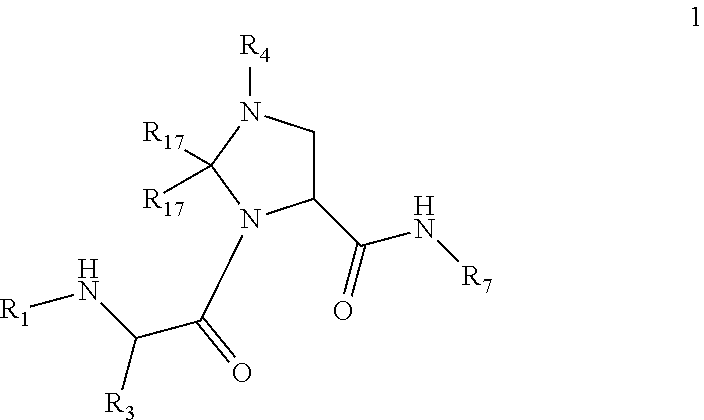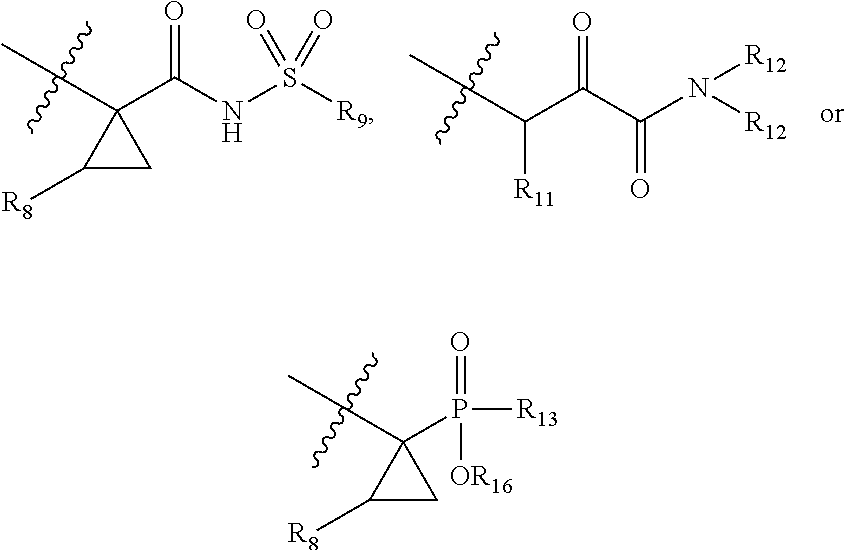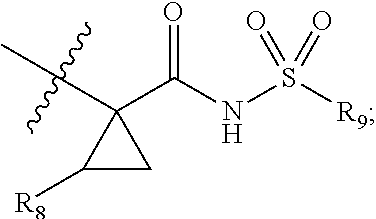Antiviral compounds
a technology of antiviral compounds and compounds, which is applied in the field of compounds with hcv inhibitory activity, can solve the problems of limited usefulness of effects, and achieve the effects of improving oral bioavailability, enhancing activity against development, and improving inhibitory or pharmacokinetic properties
- Summary
- Abstract
- Description
- Claims
- Application Information
AI Technical Summary
Benefits of technology
Problems solved by technology
Method used
Image
Examples
example 1
Preparation of Compound 1
[0230]
Step 1:
[0231]To a solution of methyl ester V (0.42 g, 0.95 mmol) in MeOH (2.0 mL) / THF (2.0 mL) was added LiOH (200 mg, 8.35 mmol) as a solution in H2O (2.0 mL). After stirring at rt for 3 h, the organic solvent was removed in vacuo, and the residue was diluted with EtOAc and the pH adjusted to 2 by HCl (1N). The aqueous phase was extracted with EtOAc and the combined organic phases were washed with brine, dried over Na2SO4, and concentrated in vacuo, affording 400 mg of carboxylic acid VII as a white solid in 98% yield. LCMS (M+1)=432.24.
Step 2:
[0232]Acid (0.4 g, 0.92 mmol) was dissolved in DMF (3 ml), amine (0.30 g, 1.7 mmol), HATU (0.9 g, 2.3 mmol) were added, followed by the addition NMM (0.52 ml, 4.8 mmol). The resulting reaction mixture was stirred at room temperature for overnight. The crude reaction solution was diluted with EtOAc and washed with 1N HCl, 5% LiOH, sat. NaHCO3, brine, dried over MgSO4, filtered, and concentrated. The crude materia...
example 2
Preparation of Compound 2
[0240]
Step 1:
[0241]To a solution of amine VI (159 mg, 0.45 mmol) in DMF (2 ml) was added Phenyl-acetic acid (130 mg, 0.97 mmol), HATU (500 mg, 1.2 mmol) and NMM (190 mg, 1.94 mmol). The resulting reaction mixture was stirred at room temperature overnight. The reaction mixture was diluted with EtOAc and washed with 1N HCl, 5% LiOH, sat. NaHCO3, brine, dried over MgSO4, filtered and concentrated. The residue was purified by flash chromatograph to give ester as a white solid (178 mg, 0.38 mmol, 84%).
[0242]LC / MS=474.20 (M++1)
Step 2:
[0243]Methyl ester hydrolysis was carried out by the same procedure as described in Example 1, Step 1.
Step 3:
[0244]To a solution of product from Step 2 (90 mg, 0.195 mmol) in DMF (2 ml) was added amine (70 mg, 0.235 mmol), HATU (190 mg, 0.5 mmol) and NMM (100 mg, 1.0 mmol). The resulting solution was stirred at room temperature for two hours. The reaction mixture was purified directly by preparative HPLC to give Compound 2 (60 mg, 0.0...
example 3
Preparation of Compound 3
[0247]
[0248]To a solution of VI (80 mg, 0.24 mmol) in DCM (2 ml) cooled at 0° C. was added pyridine (35.5 mg, 0.35 mmol), CbzCl (55 mg, 0.324 mmol). The reaction mixture was stirred at room temperature for 3 hours. The reaction mixture was diluted with EtOAc and washed with NaHCO3, brine, dried over MgSO4, filtered and concentrated. The residue was purified by flash chromatograph to give desired product (100 mg, 0.2 mmol, 83% yield) as white solid
[0249]1H NMR (300 MHz, CD3OD) d 7.36 (m, 5H), 5.28 (m, 1H), 5.15 (m, 3H), 5.01 (bs, 1H), 4.92-4.81 (m, 2H), 4.11-4.08 (m, 1H), 3.84 (m, 1H), 3.70 (s, 3H), 1.82-1.58 (m, 8H), 1.05 (s, 9H)
[0250]LC / MS=490.00 (M++1)
[0251]Compound 3 was prepared from product obtained above using the same procedures described in Example 2 (Step 2 and Step 3) for Compound 2.
[0252]1H NMR (300 MHz, CD3OD) d 7.37 (m, 5H), 5.70-5.64 (m, 1H), 5.33-5.28 (m, 2H), 5.18-5.12 (m, 3H), 5.02 (s, 1H), 5.57 (m, 1H), 4.10 (s, 1H), 3.90 (m, 1H), 3.65 (m, ...
PUM
| Property | Measurement | Unit |
|---|---|---|
| wt. % | aaaaa | aaaaa |
| wt. % | aaaaa | aaaaa |
| wt. % | aaaaa | aaaaa |
Abstract
Description
Claims
Application Information
 Login to View More
Login to View More - R&D
- Intellectual Property
- Life Sciences
- Materials
- Tech Scout
- Unparalleled Data Quality
- Higher Quality Content
- 60% Fewer Hallucinations
Browse by: Latest US Patents, China's latest patents, Technical Efficacy Thesaurus, Application Domain, Technology Topic, Popular Technical Reports.
© 2025 PatSnap. All rights reserved.Legal|Privacy policy|Modern Slavery Act Transparency Statement|Sitemap|About US| Contact US: help@patsnap.com



